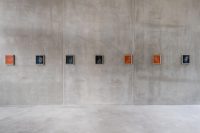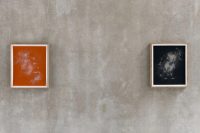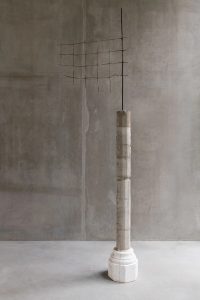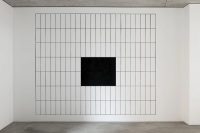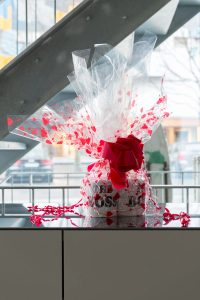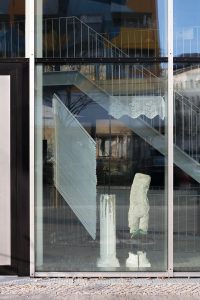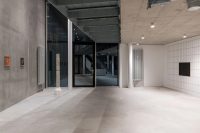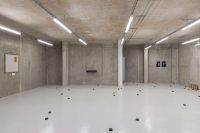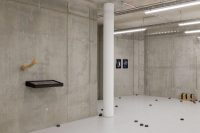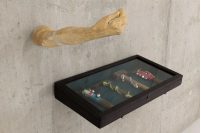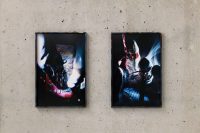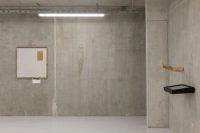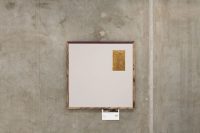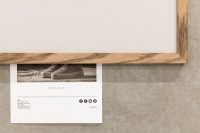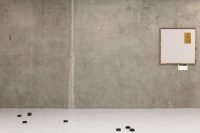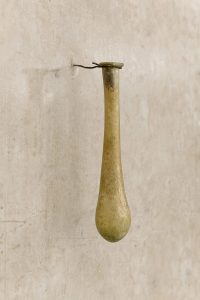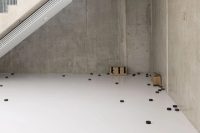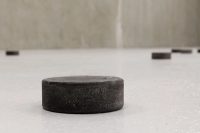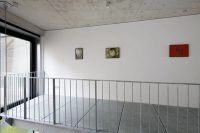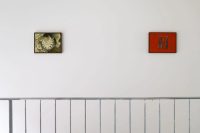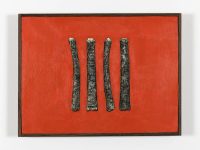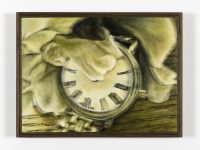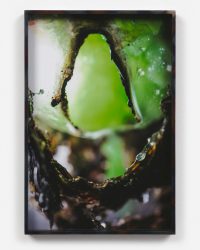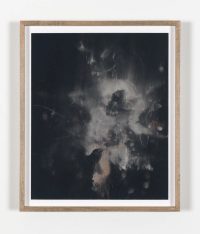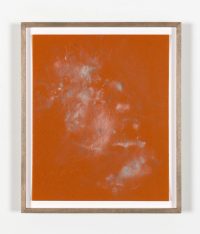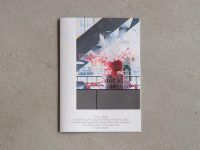Love’s work. The phrase is potent and immediate. It’s persistent—let it get stuck in your head like a line from a pop song. Or follow the trails of its many permutations: what kind of labor belongs to love? Or stems from it? What does it mean to equate the two? Lifted from English philosopher Gillian Rose’s chronicle of her life, published shortly before she died of cancer in 1995, Love’s Work also nods to her reflection on the revelatory power of vulnerability. The book opens with an epigraph from Orthodox monk Staretz Silouan “Keep your mind in hell, and despair not” and concludes with Rose’s emphatic declaration, “I will stay in the fray, in the revel of ideas and risk; learning, failing, wooing, grieving, trusting, working, reposing—in this sin of language and lips.”
This exhibition brings together the work of seven artists who, in wildly varied ways, broach art as a form of love’s work. These are practices that pay attention to desire and attempt to tap into meaning on a material level. Artmaking as love’s work is implicitly experimental—expounding no thesis, feeling for the margins, moving towards the unknown. Critique emerges as an imaginative mode. And often a way of mourning. Consciousness of the conditions—embodied, institutional, sociopolitical—that inform the production and circulation of the artwork is a throughline as these artists are considerate of the stakes of participating in that ecosystem. Making art like it’s love’s work means being aware of how one takes part: tending to the boundaries between self and artwork, whether that manifests as wholehearted investment or some kind of opting out. Either way it’s about care and complicity. And carving out a space for something like hope.
Through site-specific installations and interventions, Dora Budor positions architecture and institutions as systems with complex inner workings. She approaches these physical and bureaucratic structures as bodies that metabolize their political, cultural, and historical contexts and as beings that can be pathologized. As such, her work is often concerned with homing in on the border between interiority and exteriority and choreographing slippages and reversals of this partition: internalizing exteriors and externalizing interiors. In Love Streams (2022) sandpaper acts as a recurring background for a series of automatic frottages, made by the after-hours rubbing of escitalopram onto the floor and walls of the artist’s studio. Prescribed to treat depressive disorder and generalized anxiety disorder, the ingestible (and thus invisible) substance is repurposed as a raw material in apparitions that lay bare connections between body, psyche, and biopolitical structures. In Pucks (bagarreurs) (2021), the disciplinary tension associated with caffeine, a stimulant central to assimilating body rhythms into labor conditions, is released into the gallery. Leftover coffee grinds collected from the cafe at the Kunsthaus Bregenz in the months prior to Continent, Budor’s exhibition there earlier this year, were molded into solid disks replicating the dimensions of a standardized hockey puck. Pucks (bagarreurs) transforms what is usually a place for contemplation of art objects into the arena of an exceptionally physical and confrontational sport. These temporary anchor points also resemble a multitude of periods or ellipses that mark a linguistic instability or a disorienting negation of space.
In sculpture, installation, drawing and text, Jesse Darling destabilizes dominant narratives propped up by the likes of ideology, religion, mythology and politics, exposing a fundamental precarity in any claim to coherence. Recent works like Corpus (Half-Staff) (2022) and Inter Alia (2022) stand as the ruined relics of crumbling empires, picking up on how the (aesthetic and symbolic) pillars of (what understands itself as) western civilization converge around ideologies of the border. Darling reflects on a society surveyed, policed, and privatized, municipalities impoverished, and systems and people on the brink of exhaustion and collapse. AA half-mast flag of rusted steel fencing and lace and Venetian blind banners erected from concrete and polystyrene posts convey the flimsiness of these controlling infrastructures with both humor and grief. Darling takes the fiddly flourishes that dress up empire building to task in faulty parodies of its theatrical artifice. In Deeds II (2022), tools of violence are adorned like distracting toys, as ribboned hammers that resemble babies’ rattles, jesters’ batons or morris dancers’ sticks speak to scripts of labor, gender, and identity. Hands are a recurrent motif in Darling’s oeuvre and here a roughly constructed arm with an open palm extends from the wall as if to alludeto the messy and unfinished labor of coalition-building and collectivity.
Ghislaine Leung’s work revolves around the contingencies of art’s context. She works with scores in a mode of production she terms “constitutional critique”—or an inquiry into “how we internalize institutions and constitute, in bodily terms, their written and legal industrial design [and] the negotiation of rights.” Bosses II (2019), a pair of readymade mugs extravagantly wrapped in heart-dotted plastic and a big red bow, is a compelling example of her expansion of the terms of critique from specificity towards contingency. First presented as an edition of twenty in Leung’s exhibition at London’s Chisenhale Gallery, the three sets of mugs exhibited here map the registers of romance and the workplace onto another, while also invoking power dynamics within relationships. Hours (2022) offers another take on tensions between life, love, and work, and marks a shift in Leung’s practice, as she turns her astute attention previously directed at institutional structures to the conditions of her own life and artistic production. An incarnation of the score, “A wall painting the size of the artist’s home studio wall divided into all the hours of the week with the portion of studio hours available to the artist marked in black,” the work imbues the Modernist grids of Blinky Palermo or Agnes Martin with the lived limitations of being an artist with a child and multiple jobs. As Leung articulates, this work manifests, “a negotiation of what it means to have dependencies and be dependent. It is a negotiation of what it means to value the labor of maintenance. It is a negotiation of what it means to hold out and resist binarized identities.”
Lydia Ourahmane interweaves personal and political histories into minimalist installations that often deploy light, sound, and talismanic objects. Her elliptical narratives consider the visceral experience of colonialism’s mechanisms of control, drawing in particular on the colonial past and illiberal present of her native Algeria. Her work gravitates towards the unassimilable, as manifested in transcendent energy or experiences of wonder. Ourahmane’s attention to the opacities and stipulations of bureaucracy often functions as the underbelly of her psychic ecosystems. The blown glass Tear Catcher, an antique artifact from ca. 400 B.C. that Ourahmane purchased on eBay, stands as a formal incarnation of the reflection on questions of loss and empathy that motivate Ourahmane’s practice. Historically used to measure the duration of grief, the implement caught tears to be buried with the body of a beloved. The object also evokes the sound of crying, nodding to Ourahmane’s broader concern with the guttural and equalizing qualities of the sonic medium.
Ima-Abasi Okon works with sculpture, sound, and video to create installations that function like linguistic and grammatical structures. Reworking and swapping arrangements of varietal objects in a sentence-like syntax, Okon attempts to imbue hand-made and mass-produced items with a spiritual charge by way of a material rearticulation. This process draws attention to how materials are embedded in and exhausted by capitalist systems, exploring how systems of taste, value, and excess are formed—and how they might be reimagined. For Aspirational-LY appraised targeted HIGHLIGHTS —The Entanglement is Quantum; Resonating Frequencies as Mahalia GETS OVER over-over! Positioning [Non-residential entry] devices – s4 epEIGHT luscious!!RECAP!!, 2016-2017/ 2019 & 2022, part of the “Mahalia Jackson” series, Okon worked over a panel of Oriented Strand Board (OSB), a cheap engineered sheet wood, in thick layers of classic oak polyurethane wood varnish, and placed it in an unconventional and decorative wooden (zebrano and purple heart) frame. Enclosed is a double passe-partout, leaving only a small area of the painted surface visible. A printed email, an invitation to enter a lottery draw for a limited edition pair of sneakers, juts out from the bottom of the frame. Just as her objects constitute only one aspect of a wider pedagogy, so too do they direct towards invisible or extra-dimensional qualities beyond their physicality. Regarding the series, Okon suggested, “Whenever Mahalia is referenced in the title, know that there’s a conjuring of hope. Go and sit with Mahalia, everything you need to know about how these works operate or attempt to [operate], is with her.”
Diane Severin Nguyen’s photographs and videos focus on subject matter in states of transformation, probing the division between the intimate and alienating. As she experiments with improvised assemblages of light and material in the studio, Nguyen pressures the camera to work against the impulse to identify and more towards a place of feeling. Promise to Witness (2019) and Story Control (2019) are notable works due to their site specificity, as they were made during a residency in Hong Kong amidst the 2019 protests. Conjuring the particular intensity of the light there, and employing found objects from public spaces, these images refract moments that were witnessed during a period of significant political upheaval and formation. The works embody the artist’s broader interest in how the camera facilitates our desires for individuation and identification, especially within a revolutionary context. Raindrop Bodywork (2019) is more abstract, as a dewy, green orifice crystallizes in and out of focus. Her play with contrast and contradiction extends to the works’ frames, which she burns to create an iridescent patina that looks almost wet.
I.N. Cape is an artist who paints under a pseudonym. They work serially in near-identical compositions, recently of stars, clocks and tally sticks—ancient memory aid devices used to record and document debts and other transactions. Two works from the latter two series, both Untitled (2019), are exhibited here. In obscuring their identity, I.N. Cape removes questions of authorship from painting to emphasize instead an exercise in the mediation of images. Working from screenshots and photographs of reproductions, their repeated images intervene like a stuttering pause in the act of endless scrolling.
— Camila McHugh

